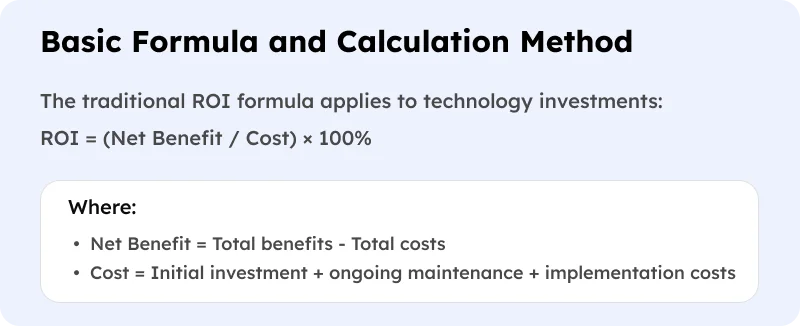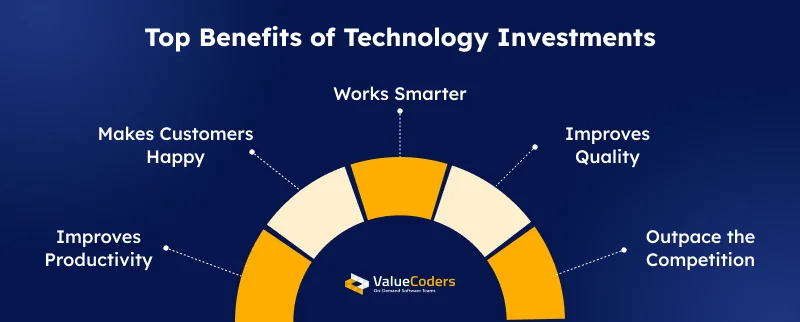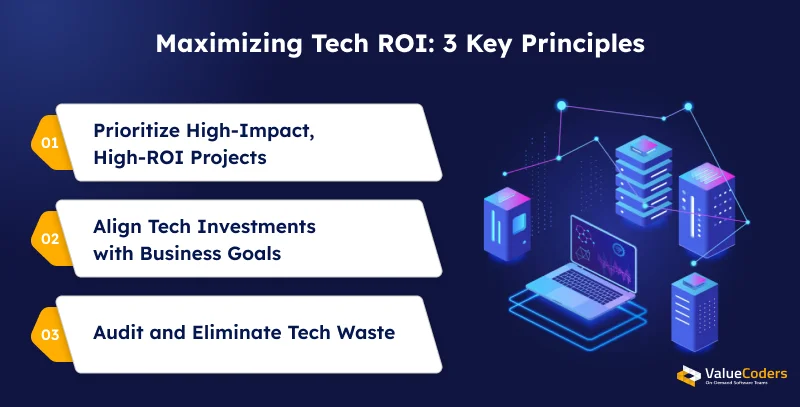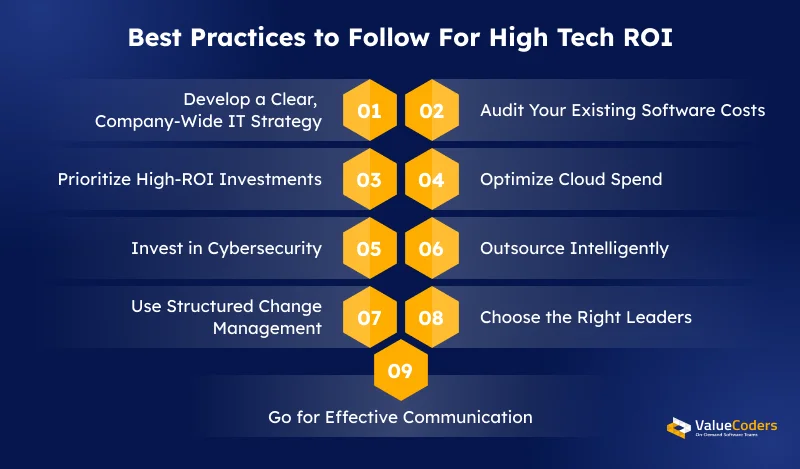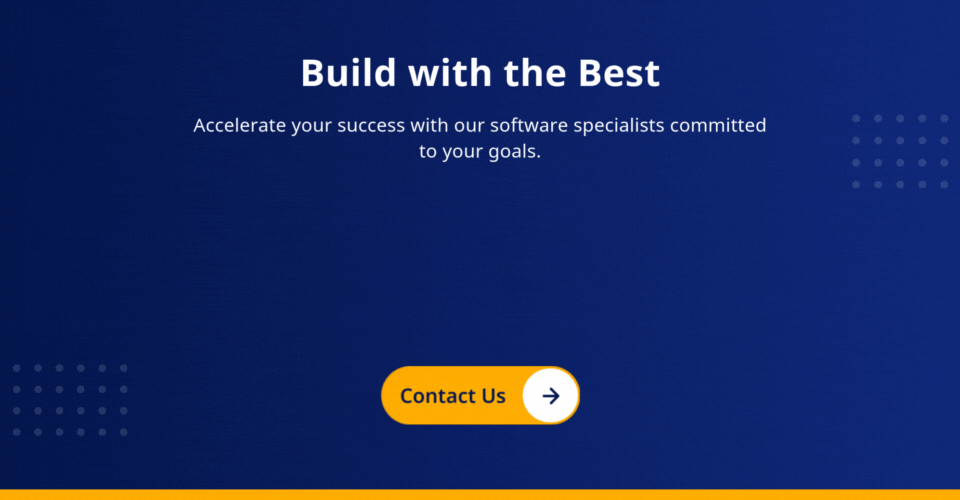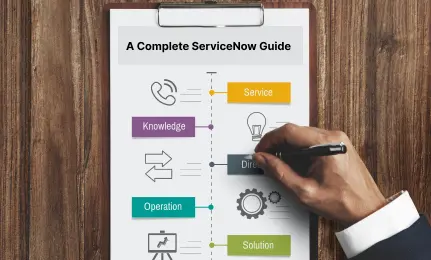A report from Statista shows that the average spending in the IT services market is increasing, reaching US$420.94 in 2025. According to the global comparison, the US is expected to generate the highest revenue, valued at US$ 550.28bn in 2025.
The above stats clearly show that modern businesses are investing heavily in the latest technologies and software development services to increase their profits. However, without tracking ROI (return on investment), these investments could be a waste of money.
The biggest challenge among modern businesses is to gain maximum technology investment returns.
With digital tools checking every aspect of business operations, businesses require clear strategies to ensure their tech dollars generate meaningful returns. Let’s explore how you can measure, track, and maximize the return on your technology investments in 2025 and beyond.
Tech ROI & Its Importance in Businesses 2025
Return on Investment (ROI) serves as a fundamental metric for evaluating the success of technology investments. In its simplest form, technology ROI measures the benefit gained relative to the cost of the investment.
For technology investments, benefits typically include:
- Revenue increases from new capabilities
- Cost savings from automation or efficiency
- Reduced downtime or risk mitigation value
- Productivity improvements
Costs encompass:
- Hardware and software purchases
- Implementation expenses
- Training and change management
- Maintenance and upgrades
- Support staff and infrastructure
Short-term & Long-term ROI
Short-term ROI focuses on immediate gains such as:
- Reduced manual labor hours
- Decreased operational expenses
- Quick productivity boosts
- Immediate cost savings
Long-term ROI considers ongoing and future benefits:
- Business growth capabilities
- Market position improvement
- Customer retention increases
- Innovation capacity
- Business continuity assurance
Leverage 675+ experts to cut costs, boost efficiency, and maximize value.
Key Advantages of Technology Investments
Let’s look at the top benefits of tech investments for your business:
Improves Productivity
- Modern technology tools enable employees to accomplish tasks faster with few errors
- Cloud-based systems allow teams to work from anywhere
- Facilitates faster communication and decision-making
- Time-tracking software helps identify bottlenecks
- Automation eliminates repetitive manual tasks
Happy Customers
- Enhances customer experiences by providing faster service
- Personalized interactions and multiple communication channels
- CRM systems help track preferences and history
- Enables more meaningful engagement
- Self-service options give customers control over their experience and support 24/7
Works Smarter
- Technology allows businesses to gather and analyze data for better decision-making
- Business intelligence tools convert raw information into meaningful data
- Machine learning helps detect patterns humans might miss
- Workflow management systems ensure consistent processes
Improves Quality
- Digital quality control tools catch errors before products reach customers
- Project management software keeps initiatives on track and maintains standards
- Automated testing finds software bugs early in development
- Digital documentation creates clear audit trails and ensures compliance
Outpaces the Competition
- Technology adoption gives businesses a competitive edge
- Faster market responses and unique service delivery methods
- Early tech adopters often capture market share before competitors can react
- Digital marketing tools help reach targeted audiences efficiently
Also Read: Navigating the Future with Technology Consulting Services for Business Growth
3 Key Principles for Maximizing Technology Investment Returns
Have a look at the top three key principles of IT for maximizing ROI on technology, as given below:
1. Prioritize High-Impact, High-ROI Projects
Focus on automation, cybersecurity, cloud migration, and customer-facing tech. These categories consistently deliver strong technology investment returns across industries.
Automation reduces labor costs while improving accuracy; cybersecurity prevents costly breaches; cloud services reduce infrastructure expenses; and customer-facing tools directly impact revenue.
Measure both short-term efficiencies and long-term strategic outcomes. While immediate cost savings matter, the most valuable business technology investments create new capabilities that transform business models or open new markets.
2. Align Tech Investments with Business Goals
Treat IT as a business driver, not a cost center. Too many organizations view technology as an expense rather than an investment that drives business value. This mindset shift requires leadership to understand how technology directly contributes to business outcomes.
Use an IT roadmap to support measurable objectives (e.g., scaling, automation, compliance). A strategic technology roadmap connects specific investments to business goals.
3. Audit and Eliminate Tech Waste
Regular software audits uncover unused licenses and overlapping subscriptions. Many organizations waste 20-30% of their software budget on unused or underutilized tools. Implementing software asset management practices helps identify these opportunities for cost recovery.
Replace underperforming tools with more agile or affordable alternatives. Legacy systems often accumulate maintenance costs while delivering diminishing returns.
Modern SaaS alternatives frequently offer better functionality at lower total costs when implementation and support expenses are factored in.
Get free consultation and let us know your project idea to turn it into an amazing digital product.
Important Questions to Analyze in Technology Investment Returns
Here is the list of questions you must analyze before making heavy investments in technology:
Do the resources invested in technology give the maximum possible returns?
This question requires benchmarking against industry standards and careful measurement of outcomes against initial projections. Organizations need mechanisms to compare actual returns against potential returns and adjust strategies accordingly.
What challenges do organizations face in managing technology transformation?
Common challenges include resistance to change, lack of digital skills, poor project management, and failure to account for total costs of ownership. Understanding these barriers helps businesses develop mitigation strategies before launching major technology initiatives.
What do organizations that achieve success as measured by return on investment emphasize?
Successful organizations typically emphasize the following:
- Clear business cases with measurable outcomes
- Strong executive sponsorship
- User involvement in selection and implementation
- Comprehensive training and change management
- Regular post-implementation reviews
- Continuous improvement cycles
What do those who are not satisfied with the results of their technology investments overlook?
Dissatisfied organizations often overlook:
- Hidden costs beyond the initial purchase
- Change management requirements
- Integration with existing systems
- Data quality issues
- Security implications
- User adoption barriers
Also Read: Digital Transformation Essentials for Modern Businesses
Technology ROI for Different Business Functions
Let’s look at the following tech ROIs of various business functions, as discussed below:
IT Infrastructure Investments
Infrastructure investments like networks, servers, and data centers form the backbone of business operations. While traditionally viewed as cost centers, modern approaches focus on how these investments enable business agility.
Key metrics include:
- System uptime percentage
- Mean time between failures
- Energy efficiency improvements
- Space utilization in data centers
- Disaster recovery capabilities
- Support ticket reduction
Cloud infrastructure offers particularly compelling ROI cases by shifting from capital expenditure to operational expenditure models while improving scalability.
Software Development Projects
Custom software development delivers maximum ROI when it addresses unique business needs that off-the-shelf solutions cannot.
- Successful software projects measure:
- Process automation savings
- Error reduction percentages
- Time saved per transaction
- User satisfaction scores
- Customer retention improvements
- New revenue opportunities created
Agile development approaches tend to generate better technology investment returns by delivering value incrementally and allowing for course correction based on market feedback.
Automation of Digital Transformation Objectives
Automation represents one of the fastest paths to measurable technology ROI. By replacing manual processes with automated workflows, businesses reduce labor costs while improving accuracy and consistency.
Common automation ROI metrics include:
- Labor hours saved
- Error reduction
- Process cycle time improvements
- Volume capacity increases
- Compliance improvement
- Customer satisfaction gains
Robotic Process Automation (RPA) typically shows returns in months rather than years when applied to repetitive, rule-based processes.
Data Analytics Investments
Data analytics transforms information into business value through better decision-making. While harder to quantify than operational improvements, analytics investments often deliver substantial strategic advantages.
ROI measurement approaches include:
- Revenue increases from data-driven decisions
- Cost reductions from predictive maintenance
- Fraud prevention savings
- Market share gains from customer insights
- Inventory optimization savings
- Price optimization revenue gains
Organizations with mature data practices typically outperform competitors by 5-6% in productivity and profitability.
With the help of our digital transformation experts, we enable companies to cut costs, improve efficiency, and boost profits.
Cybersecurity Expenditures
Cybersecurity investments present unique ROI calculation challenges since their value lies primarily in prevented losses rather than created gains.
Risk-based ROI models consider:
- Breach likelihood reduction
- Potential data loss costs avoided
- Regulatory fine avoidance
- Insurance premium reductions
- Business continuity assurance
- Customer trust preservation
Companies that treat security as an investment rather than insurance tend to implement more effective programs that protect while enabling business innovation.
Smarter Technology Investments
Smart technology deployments focus on integration and ecosystem benefits rather than point solutions. The interconnection of systems creates multiplicative value beyond individual tool benefits.
Examples include:
- IoT sensors feeding predictive maintenance systems
- CRM data enhances marketing automation
- Supply chain visibility improves inventory management
- Unified communications boosting collaboration
Businesses achieve the highest returns when technologies work together to transform processes rather than merely digitizing existing workflows.
Also Read: How to Measure and Improve Digital Marketing ROI
Common Pitfalls to Avoid
Here is the list of some common mistakes you must avoid before you invest in technology:
Ignoring Hidden Costs
Many technology projects exceed budgets due to overlooked expenses beyond the initial purchase prices. Complete cost modeling should include:
- Implementation services
- Data migration expenses
- Integration requirements
- Training needs
- Business process changes
- Infrastructure updates
- Ongoing support
- License growth
- Upgrade cycles
Organizations that perform comprehensive cost analysis before investment decisions obtain IT budget optimization by 45%.
Failing to Sunset Outdated Tools
Technology portfolios grow organically over time, leading to redundancy and waste. Regular rationalization ensures resources focus on high-value systems.
Signs a system needs retirement include:
- Low usage metrics
- High maintenance costs
- Security vulnerabilities
- Integration difficulties
- Better alternatives available
- Changing business requirements
Companies that actively manage technology lifecycles typically reduce IT operating costs by 15-20% while improving overall performance.
Underestimating Change Management Needs
People naturally resist change, and technology adoptions fail when human factors receive insufficient attention. Successful implementations allocate 15-20% of project budgets to change management activities.
Common change management mistakes include:
- Insufficient training resources
- Poor executive sponsorship
- Inadequate user involvement
- Unclear benefit communication
- Failure to address workflow impacts
- Lack of post-implementation support
Projects with robust change management are 2.5 times more likely to meet or exceed ROI expectations.
Tracking Only Financial ROI — Missing Broader Strategic Value
Many technology benefits extend beyond direct digital financial management. Complete evaluation frameworks include both quantitative and qualitative impacts.
Strategic value categories include:
- Market positioning improvements
- Customer experience enhancements
- Employee satisfaction gains
- Innovation capacity building
- Business model opportunities
- Risk reduction outcomes
- Compliance improvements
- Competitive differentiation
Organizations that measure both financial and strategic outcomes make more balanced investment decisions and achieve better long-term results.
Also Read : Why Custom Software Development Saves Enterprises Millions in the Long Run
Best Technology Investment Strategies To Achieve Higher Returns
Let’s look at the top tech investment strategies that can bring you higher returns:
1. Develop a Clear, Company-Wide IT Strategy
A comprehensive IT investment strategy aligns technology investments with business goals and provides a framework for evaluating opportunities. This strategy should map technology capabilities to business outcomes with clear priorities and timelines.
Elements of effective IT strategies include:
- Business capability maps
- Technology maturity assessments
- Future state architecture vision
- Investment prioritization framework
- Skills development roadmap
- Governance model
Organizations with documented IT strategies achieve 20-30% higher returns on their business technology investments compared to those making ad hoc decisions.
2. Audit Your Existing Software Costs
Before making new investments, companies should thoroughly review current technology spending to identify waste and optimization opportunities.
Effective software audits include:
- License utilization analysis
- Subscription review and consolidation
- Maintenance contract evaluation
- Support cost assessment
- Usage pattern analysis
- Integration efficiency review
Companies typically find 10-15% immediate savings opportunities through systematic software audits.
3. Prioritize High-ROI Investments
Not all technology investments deliver equal returns. Smart organizations develop frameworks for identifying and prioritizing initiatives with the greatest impact potential.
High-ROI categories commonly include:
- Customer experience technologies
- Process automation tools
- Cloud migration projects
- Data analytics capabilities
- Mobile enablement
- Security enhancements
Using scoring models that weight business impact against implementation complexity helps identify “quick win” opportunities with maximum returns.
4. Optimize Cloud Spend
Cloud services offer flexibility but can lead to unexpected costs without proper management. Cloud cost optimization strategies deliver immediate ROI while maintaining performance.
Effective cloud optimization includes:
- Right-sizing computing resources
- Implementing auto-scaling policies
- Utilizing reserved instances
- Identifying idle resources
- Managing data transfer costs
- Deploying multi-cloud strategies where beneficial
Organizations typically reduce cloud costs by 25-35% through systematic optimization efforts.
5. Invest in Cybersecurity
Security investments deliver returns by preventing costly breaches and maintaining customer trust. A risk-based approach ensures protection matches business needs without overspending.
Smart security investments focus on:
- Critical asset protection
- Threat intelligence
- Security automation
- Employee awareness training
- Third-party risk management
- Incident response capabilities
Companies that implement comprehensive security programs avoid an average of 60% of potential breach costs compared to those with basic security measures.
Maximize returns on every project with scalable, custom-built solutions from our experienced development teams.
6. Outsource Intelligently
Selective outsourcing allows businesses to access specialized expertise without maintaining in-house capabilities for every technology need.
Effective outsourcing strategies include:
- Core vs. context analysis
- Managed service evaluation
- Staff augmentation for peak demands
- Project-based engagements
- Development partnerships
- Global talent utilization
Organizations that outsource strategically while maintaining internal control of core capabilities typically achieve 15-20% cost savings while improving quality.
7. Use Structured Change Management
Technology ROI depends heavily on user adoption. Structured change management ensures that people and processes adapt to new systems effectively.
Key change management elements include:
- Stakeholder analysis and engagement
- Communication planning
- Training program development
- Change impact assessment
- Resistance management
- Success measurement
Projects with formal change management are six times more likely to meet objectives than those without such support.
8. Choose the Right Leaders
Technology initiatives require both technical expertise and business acumen. Selecting leaders who understand both domains significantly improves success rates.
Effective technology leaders demonstrate:
- Business strategy understanding
- Technical depth in key areas
- Communication skills across departments
- Change management capabilities
- Financial acumen
- Risk management experience
Organizations with technology leadership that bridges IT and business consistently achieve 25% higher returns on their tech investments.
9. Go for Effective Communication
Clear communication about technology investments helps secure buy-in, manage expectations, and drive adoption.
Communication best practices include:
- Business value articulation
- Plain language explanation of technical concepts
- Regular progress updates
- Success story sharing
- Challenge transparency
- Feedback mechanisms
Companies that communicate technology value effectively experience 30% higher adoption rates and corresponding ROI improvements.
Also Read: Cybersecurity in Software Development: Why it Matters More Than Ever
How Can ValueCoders Help You Maximize Returns?
Maximizing technology investment returns is not just about cutting costs. It is about making smarter and strategic decisions that can lead to long-term success.
By aligning your technology spending with your business goals and investing in scalable solutions for better efficiency, you can turn each tech dollar into a competitive advantage.
With 20+ years of industry experience and 675+ top-tier developers, ValueCoders help helps businesses identify, implement, and maximize returns from technology investments through:
- Custom software development
- Digital transformation strategies
- IT consulting services
- Robust software project management
- Post-implementation support
We use systematic approaches for technology investment planning that bring maximum benefits and keep you ahead of the competition. Contact us today!


